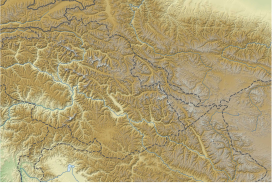| Saltoro Kangri | |||
|---|---|---|---|
| Traditional Chinese | 薩爾托洛崗日峰 | ||
| |||
Saltoro Kangri, previously known as Peak 36, stands as the highest peak within the Saltoro Mountains subrange, which is part of the larger Karakoram range. This subrange is also referred to as the Saltoro Range and is situated within the Karakoram region. The term "Saltoro Kangri" typically encompasses both of its twin peaks, Saltoro Kangri I (located to the south) and Saltoro Kangri II, which are connected by a saddle. When comparing heights, the generic term "Saltoro Kangri" is used for the taller of the two peaks, Saltoro Kangri I. This peak ranks as the 31st highest mountain globally and is located in the remote reaches of the Karakoram. It lies on the Actual Ground Position Line, dividing Indian-controlled territory in the Siachen region from Pakistani-controlled territory to the west of the Saltoro Range.
Climbing history
The mountain underwent reconnaissance by Fanny Bullock Workman and her husband in the year 1911-12. The initial endeavor to conquer the peak, which was then denoted as "Peak 36," took place in 1935, led by a British expedition headed by James Waller and John Hunt. Hunt's involvement in the expedition had been suggested by the Himalayan Club in Calcutta. Among the expedition's members were Rowland Brotherhood and Dr. Steward Carslaw, accompanied by two Sherpas named Palden and Dawa Thondup. Their approach to the mountain commenced from the Likah Glacier, with the objective of ascending the South East ridge. They successfully established a final camp on June 19th, yet their altitude estimation proved to be inaccurate. An attempt to reach the summit the following day, amidst worsening weather conditions, was thwarted as they were required to ascend an additional 3500 feet. Hunt and Brotherhood managed to reach an elevation of 24,500 feet but were compelled to turn around.
In 1957, under the leadership of Eric Shipton, a British university expedition approached the mountain via the Bilafond La route, entering from Pakistan and operating under a Pakistani climbing permit. However, they chose not to make a summit attempt. Unintentionally, this expedition marked the initial maneuver in the consequential oropolitics dispute over the Siachen conflict, ultimately culminating in the Siachen conflict of 1984.
The first ascent of Saltoro Kangri was in July 1962, by a joint Japanese-Pakistani expedition led by T. Shidei. This piggyback expedition put A. Saito, Y. Takamura and Pakistani climber R.A. Bashir on the top on July 24, following the S.E. ridge route. The peak was again climbed by an Indian Army expedition led by Colonel Narendra Kumar in 1981. US maps of the area and many world atlases starting in the 1960s showed the Line of Control between Pakistani and Indian territory running from the last defined point in the 1949 Karachi Agreement, NJ9842, east-northeast to the Karakoram Pass, thus putting the whole of Saltoro Kangri and the entire Siachen Glacier in Pakistan. However, the Simla Agreement defined the Line of Control no further than point NJ9842 other than with the phrase "thence north to the glaciers." The Himalayan Index lists only one more ascent of the mountain, in 1981, and no other attempts.
References
- ^ Shidei, T. (1964). "The Ascent of Saltoro Kangri" (PDF). Alpine Journal. 69: 73–80. Retrieved 2020-01-15.
- Hunt, John (1936). "Peak 36, Saltoro Karakoram, 1935". Himalayan Journal. 8. Retrieved 2020-01-15.
- Hunt, John; Waller, James (1937). "Peak 36, Saltoro Karakoram A Mountaineering Analysis". Himalayan Journal. 9. Retrieved 2020-01-15.
- Waller, James (1939). The Everlasting Hills. William Blackwood & Sons.
- Hunt, John (1978). Life Is Meeting. London: Hodder and Stoughton. pp. 35–44. ISBN 0340229632.
- Miller, K.J. (1958). "The Imperial College Karakoram Expedition, 1957". Himalayan Journal. 21. Retrieved 2020-01-15.
- Shidei, T. (1964). "The Ascent of Saltoro Kangri". Himalayan Journal. 25. Retrieved 2020-01-15.
- Kapadia, Harish (2005). Into the Untravelled Himalaya: Travels, Treks, and Climbs. Indus Publishing. p. 245. ISBN 9788173871818. Retrieved 2020-01-15.
Further reading
- Jill Neate, High Asia: An Illustrated History of the 7000 Metre Peaks, ISBN 0-89886-238-8
External links
This Indian location article is a stub. You can help Misplaced Pages by expanding it. |
This Pakistan location article is a stub. You can help Misplaced Pages by expanding it. |



